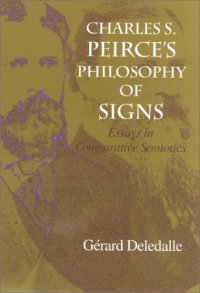
Ebook: Charles S. Peirce’s Philosophy of Signs: Essays in Comparative Semiotics
Author: Gerard Deledalle
- Genre: Other Social Sciences // Philosophy
- Series: Advances in Semiotics
- Year: 2001
- Publisher: Indiana University Press
- Language: English
- pdf
[Note: Picture of Peirce available]
Charles S. Peirce's Philosophy of SignsEssays in Comparative SemioticsGérard Deledalle
Peirce's semiotics and metaphysics compared to the thought of other leading philosophers.
"This is essential reading for anyone who wants to find common ground between the best of American semiotics and better-known European theories. Deledalle has done more than anyone else to introduce Peirce to European audiences, and now he sends Peirce home with some new flare." -- Nathan Houser, Director, Peirce Edition Project
Charles S. Peirce's Philosophy of Signs examines Peirce's philosophy and semiotic thought from a European perspective, comparing the American's unique views with a wide variety of work by thinkers from the ancients to moderns. Parts I and II deal with the philosophical paradigms which are at the root of Peirce's new theory of signs, pragmatic and social. The main concepts analyzed are those of "sign" and "semiosis" and their respective trichotomies; formally in the case of "sign," in time in the case of semiosis. Part III is devoted to comparing Peirce's theory of semiotics as a form of logic to the work of other philosophers, including Bertrand Russell, Wittgenstein, Frege, Philodemus, Lady Welby, Saussure, Morris, Jakobson, and Marshall McLuhan. Part IV compares Peirce's "scientific metaphysics" with European metaphysics.
Gérard Deledalle holds the Doctorate in Philosophy from the Sorbonne. A research scholar at Columbia University and Attaché at the Centre National de la Recherche Scientifique, Paris, he has also been Professor of Philosophy and Head of the Philosophy Department of the universities of Tunis, Perpignan, and Libreville. In 1990 he received the Herbert W. Schneider Award "for distinguished contributions to the understanding and development of American philosophy. In 2001, he was appointed vice-president of the Charles S. Peirce Society.
Contents
Introduction -- Peirce Compared: Directions for Use
Part I -- Semeiotic as PhilosophyPeirce's New Philosophical ParadigmsPeirce's Philosophy of SemeioticPeirce's First Pragmatic Papers (1877-1878)The Postscriptum of 1893
Part II -- Semeiotic as SemioticsSign: Semiosis and Representamen -- Semiosis and TimeSign: The Concept and Its Use -- Reading as Translation
Part III -- Comparative SemioticsSemiotics and Logic: A Reply to Jerzy PelcSemeiotic and Greek Logic: Peirce and PhilodemusSemeiotic and Significs: Peirce and Lady WelbySemeiotic and Semiology: Peirce and SaussureSemeiotic and Semiotics: Peirce and MorrisSemeiotic and Linguistics: Peirce and JakobsonSemeiotic and Communication: Peirce and McLuhanSemeiotic and Epistemology: Peirce, Frege, and Wittgenstein
Part IV -- Comparative MetaphysicsGnoseology -- Perceiving and Knowing: Peirce, Wittgenstein, and GestalttheorieOntology -- Transcendentals "of" or "without" Being: Peirce versus Aristotle and Thomas AquinasCosmology -- Chaos and Chance within Order and Continuity: Peirce between Plato and DarwinTheology -- The Reality of God: Peirce's Triune God and the Church's TrinityConclusion -- Peirce: A Lateral View